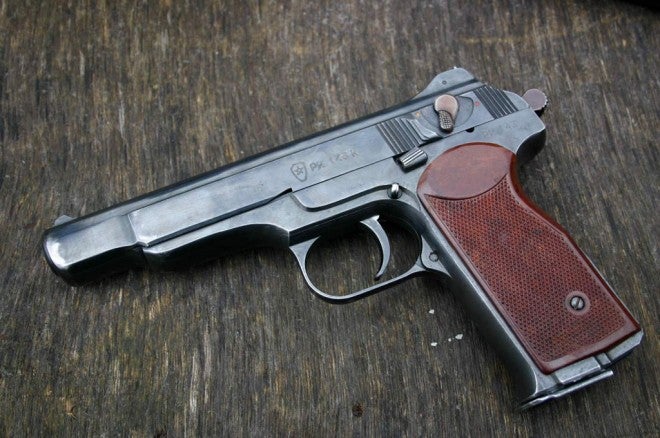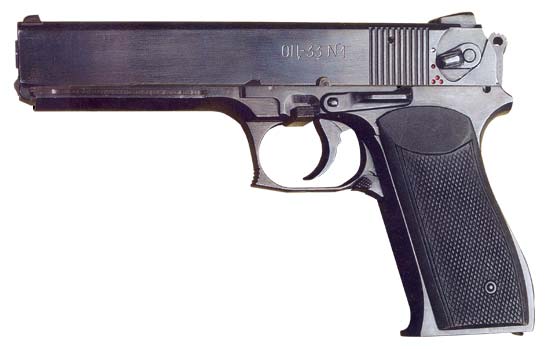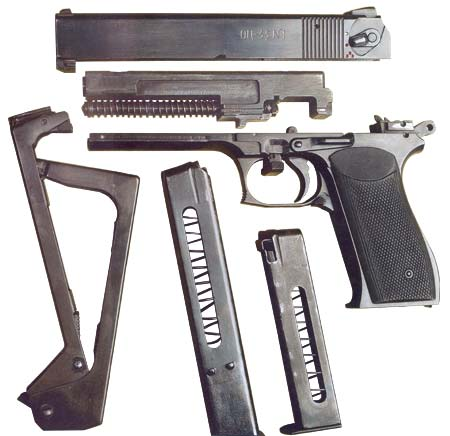The Stechkin APS received a mention in the Handgun Radio segment I collaborated on with Daniel Watters, and for good reason. It could be argued that the APS, though and obscure weapon in the West, is one of the very few truly successful machine pistol designs ever fielded by a military power.
The concept of a lightweight automatic firearm goes back to probably before the beginning of the 20th Century, but the successful implementation of the idea has so far eluded almost all who pursue it, with very few exceptions. Russian small arms developers had been playing with the idea since at least the early 1920s, and by the late 1930s were ready to adopt a machine pistol in 7.62x25mm designed by an engineer named Voyevodin. This weapon was a lightweight select-fire weapon with an 18-round double-row magazine. Like many Russian projects of the era, however, it was cancelled with the outbreak of war in 1941.
At the end of World War II, therefore, the Soviet Union sought again to procure a new pistol, as well as a new machine pistol to finally realize a lightweight personal defense weapon. In this effort, they incorporated lessons learned in the war, reducing the engineering and cost requirements of their next-generation of personal small arms by adopting an “ideal” 9mm cartridge. This was an incarnation of an idea formulated before WWII, which split the difference between full-size pistol rounds like 9mm and .45 ACP that require locked breech mechanisms to meet reasonable size and weight requirements, and smaller, lower-pressure rounds like the .25, .32, and .380 ACP, which, though impotent, were suitable for production in lightweight blowback operated pistols. Such a round could dramatically reduce the cost of procuring pistols, while not sacrificing their essential characteristics. Soviet designers Nikolay Makarov and Igor Stechkin designed weapons that would bear their name: The semiautomatic, compact PM pistol, and the select-fire, full-size APS machine pistol.
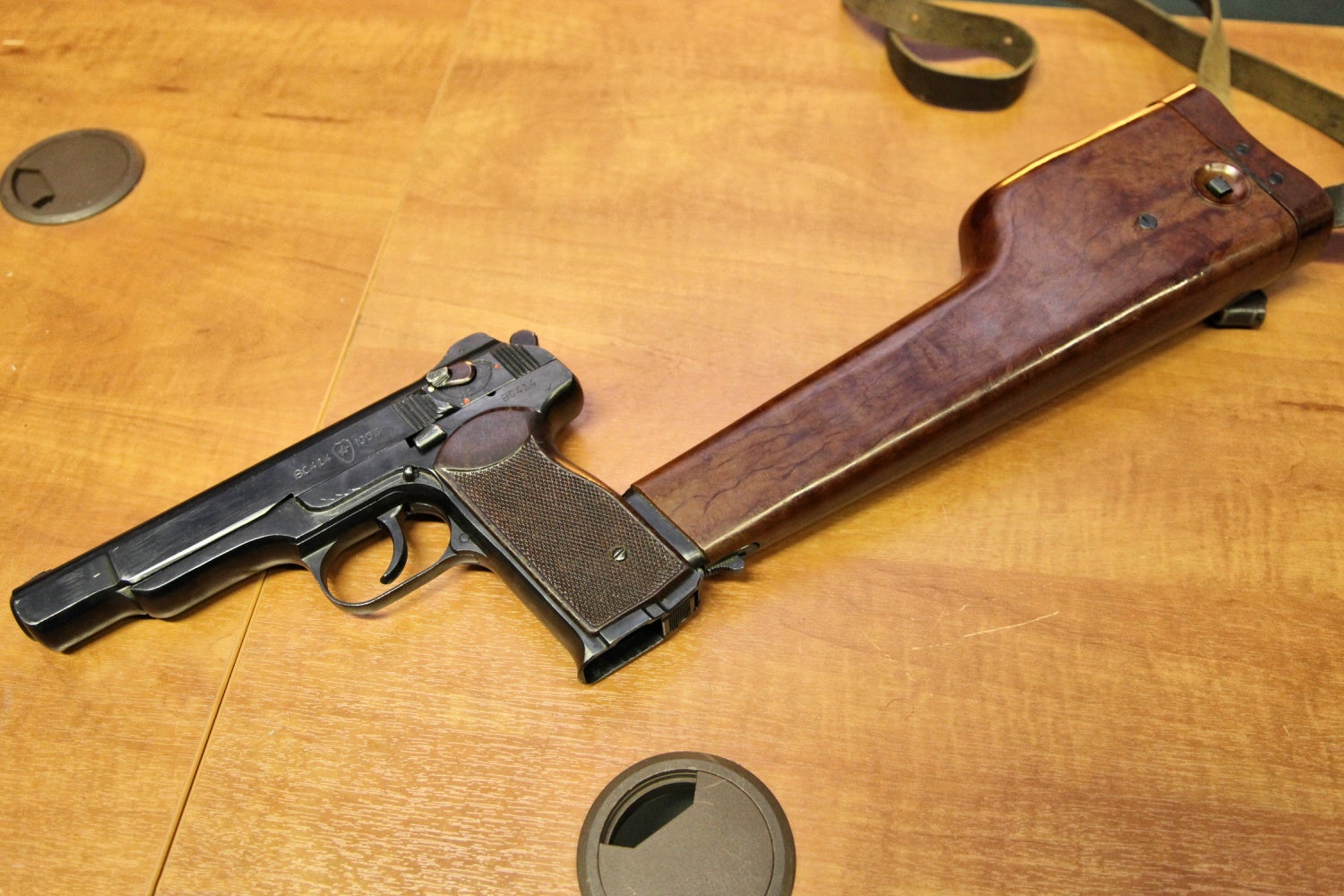
The Stechkin APS with attached resin/bakelite shoulder stock/holster. This was one of the very few successful machine pistols, but it proved too inconvenient to carry for its original intended role. Image source: wikipedia.org
The purpose of Stechkin’s new machine pistol was to give infantry a combat-capable weapon that would not interfere with other duties they had to perform. New weapons central to Soviet infantry doctrine like the RPG-2 precluded issuing even lightweight longarms like the brand-new Simonov semiautomatic carbine, as those were too unwieldy when carried with a portable anti-tank weapon. Therefore, the APS must be usable as a pistol, but to fully meet the needs of these troops also had to be useful as a submachine gun or carbine as well, and so it was given a detachable resin/bakelite shoulder stock which also doubled as a holster, very similar to the Mauser C96, which had proved so useful as a dual-purpose weapon. The addition of the stock allowed for effective use of the automatic fire mode, as well, further increasing the pistol’s utility, and, unlike the Mauser, the Stechkin was a simple, cheap weapon to manufacture and maintain.
Besides a shoulder stock, the APS also incorporates a very novel plunger-type rate reducer, to which energy is transferred during the cycling of the bolt. The plunger acts on the disconnector; when the plunger is traveling either down towards the butt of the grip, or up towards the firing mechanism, the pistol cannot fire. Once the plunger returns to its topmost position, it activates the disconnector and the gun fires. This adds a slight delay to the guns operation, and reduces the rate of fire from what would probably be well over 1,000 rds/min to a much more reasonable 700-750 rds/min. Other than the rate reducer and the select-fire mechanism, it is a very standard double/single-action blowback-operated handgun, similar to the Makarov or PPK.
The Stechkin proved relatively short-lived as the primary personal defense weapon of the Red Army. The weapon proved too bulky and large, especially with its shoulder stock/holster to be very convenient for carry for such a short-range weapon, and with the advent of compact, folding-stock AKS Kalashnikov assault rifles, the APS machine pistols were relegated to military depots and storage facilities. The Stechkin’s story would end there, as another not-very-successful machine pistol had, in the 1970s, Russian special forces (“Spetsnaz”) not discovered that it proved to be an extremely capable compact suppressor platform. APS machine pistols were modified to the APB configuration, with a longer threaded barrel, suppressor, and wire stock. These weapons achieved a great deal of success with special units, and were used throughout the Soviet invasion of Afghanistan and to the present day.
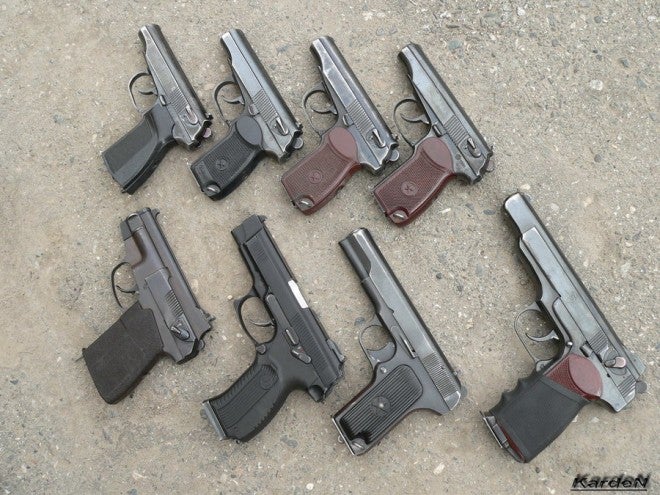
Some of the weapons used by KardeN, an MVD agent who has released a great deal of photos of his and others’ gear. This picture shows the great size of the APS machine pistol, which is much, much larger than even full-size handguns like the TT-33. Also visible is a top row of various Makarov pistols, a PSS captive-piston silent pistol, and a 9x19mm Russian PYa Grach pistol. Image source: k-a-r-d-e-n.livejournal.com
The Stechkin in fact proved so popular with these units that unmodified APS machine pistols are also in use with Russian special forces/special law enforcement teams, as they are very accurate and have a much greater capacity than PMM Makarov pistols, plus the added benefit of emergency full auto fire. These pistols, now nearing half a century old, can still be found in photos of Russian special units teams and their equipment, with plenty of wear from constant use. They are almost never seen with their original bulky shoulder stock/holsters, however, apparently being used as pure pistols, or with wire or folding stock designs.
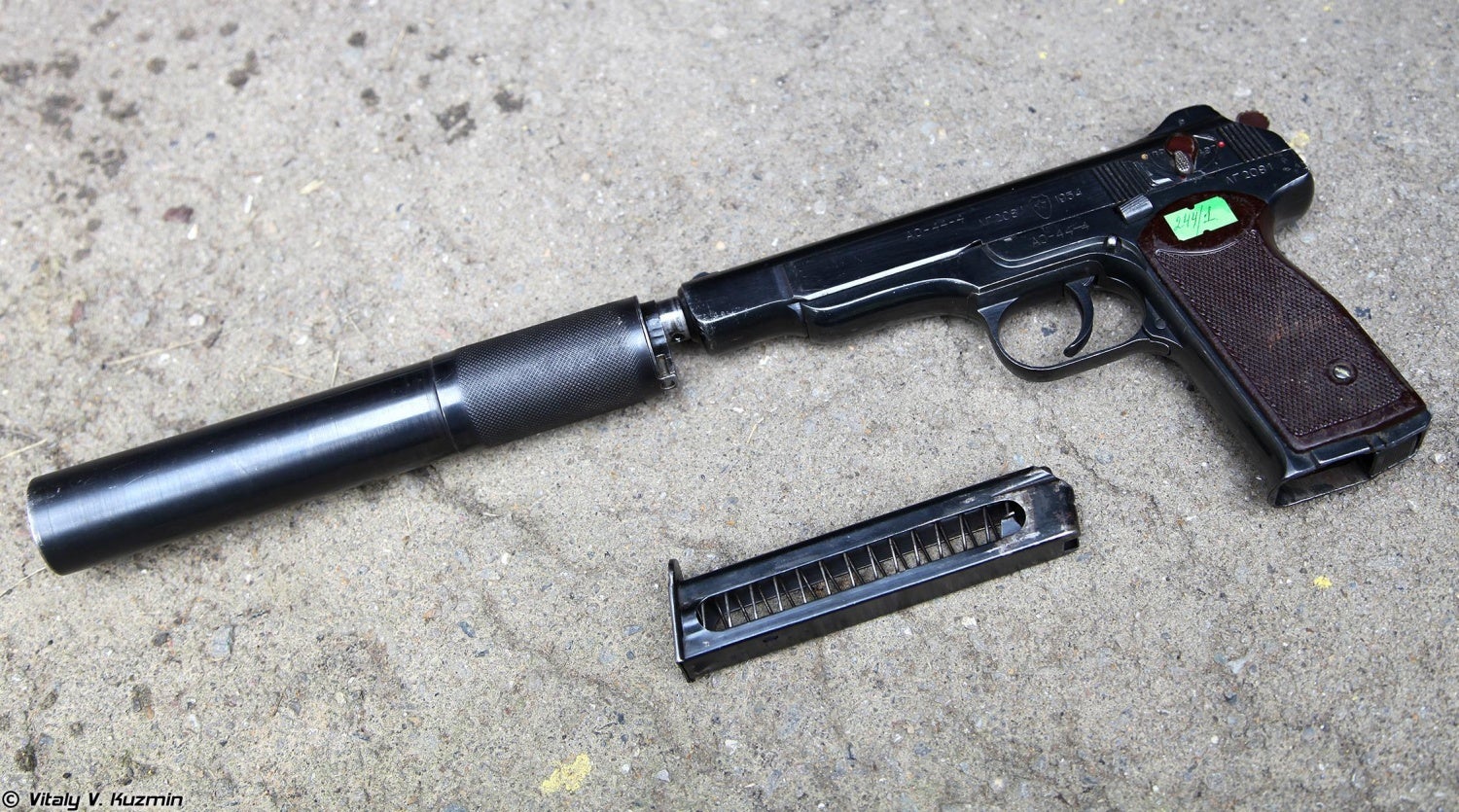
The APB suppressed variant of the Stechkin. Missing from this photo is the pistol’s wire stock, which mates with the suppressor to form a single stowable package. Image source: imgur.com
Such is the demand for these pistols, that one of Igor Stechkin’s last projects before his death in 2001 was a replacement for the APS pistol, designated the OTs-33 “Pernach” (“Mace”), which is an even simpler design with a much more compact folding sheet metal stock. The OTs-33 is reportedly currently in production and in use with some special police units, like OMON, though I have never seen pictures of it in the field. Like the APS, the OTs-33 is a double-action blowback operated hammer-fired select-fire handgun in 9x18mm PM caliber. Also like the APS, it’s very heavy and large, though made considerably more convenient than its predecessor by the folding steel stock.
The APS is therefore – by the skin of its teeth, perhaps – one of the few machine pistol success stories. Though the type was never really successful as a personal defense weapon (the Soviets would eventually develop the AKS-74U subcompact assault rifle to fill this role), as a special, close-quarters weapon for direct action police and military teams, the APS has seen a great deal of use since the 1970s. To get a sense of how effective and controllable a Stechkin APS can be, below are embedded some videos of the type in use. Also, Guns & Ammo recently released a brief treatment of the machine pistol, including a range session, which is well worth watching. At Forgotten Weapons, you can further download the manual for the APS machine pistol in either English or Russian. There is even a website devoted to Igor Stechkin and his designs, stechkin.info.
H/T, Grant Cunningham
 Your Privacy Choices
Your Privacy Choices
